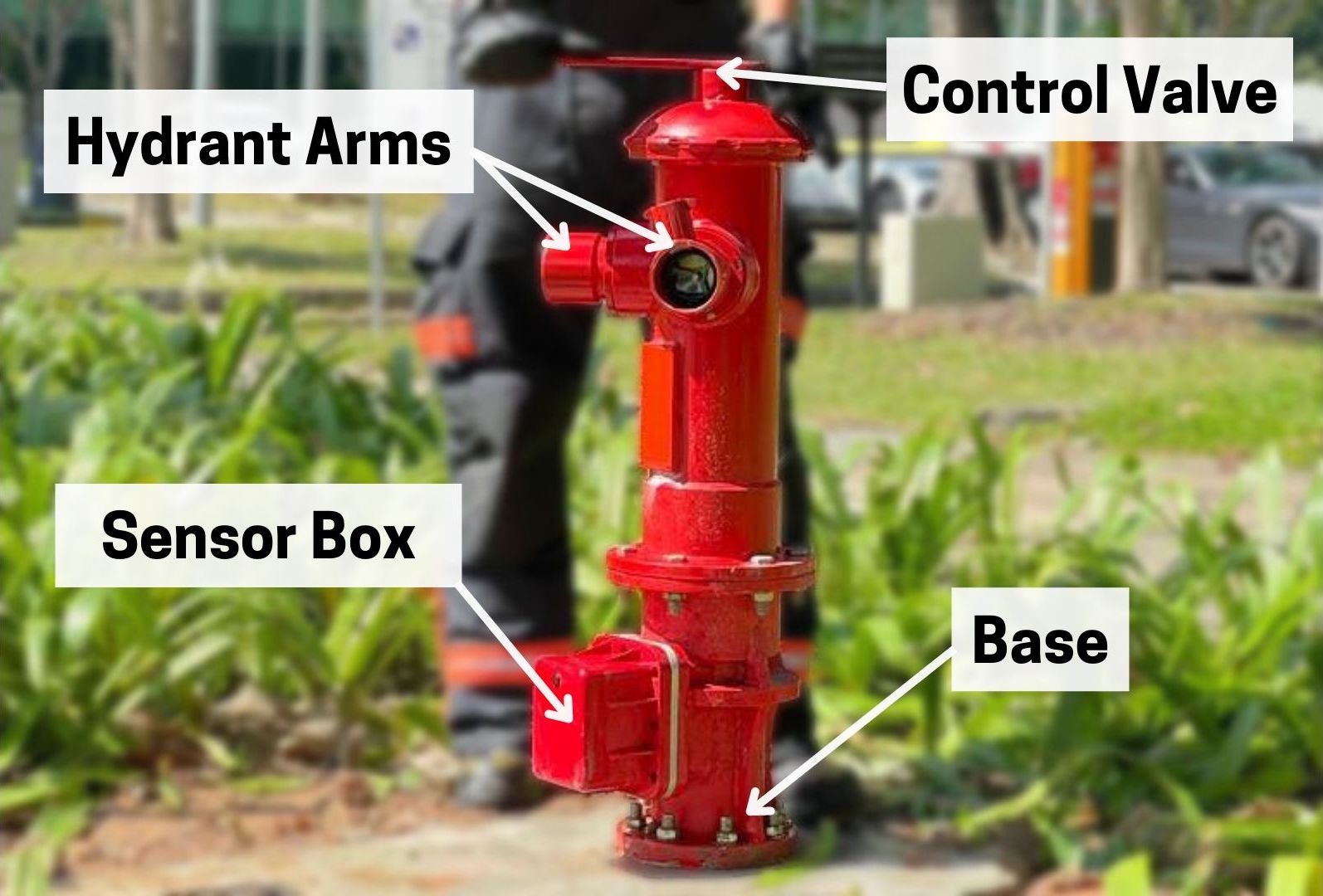In December last year, SCDF and the Public Utilities Board (PUB) introduced a pilot project on the Smart Hydrant – a newly designed, intelligent fire hydrant that is easier and faster to operate. With the Smart Hydrant, firefighters will be able to swiftly connect firefighting hoses directly to the arms of the hydrant without any adaptors and do away with the need to remove its pit cover to access the underground valve. These enhanced features along with several others will increase the speed of obtaining water supply, saving the firefighters precious time during an emergency operation such as a major industrial fire.
 The Smart Hydrant
The Smart Hydrant
Hydrants In Singapore
There are currently about 23,000 fire hydrants across Singapore and they come in three versions — Ground Hydrants, Triple Pillar Hydrants and Double Pillar Hydrants.
.jpg?sfvrsn=bd9a35f0_2) The Double Pillar Hydrant, 1986. Source: National Archives of Singapore
The Double Pillar Hydrant, 1986. Source: National Archives of Singapore
.jpg?sfvrsn=a82f1104_2) Pre-war Double Pillar Hydrant (circa 1920s). Source: SCDF/PUB
Pre-war Double Pillar Hydrant (circa 1920s). Source: SCDF/PUB
The Double Pillar Hydrants are the most common locally with 20,235 installed island-wide while the Ground Hydrants are located at the end of the water pipelines and can be used for maintenance purposes. The Triple Pillar Hydrants are typically found in commercial and industrial areas and each comes with have an additional large diameter arm to provide larger water output.
 The Ground Hydrant. Source: SCDF/PUB
The Ground Hydrant. Source: SCDF/PUB
 Triple Pillar Hydrant. Source: SCDF/PUB
Triple Pillar Hydrant. Source: SCDF/PUB
The Importance of Functioning Hydrants
Singapore has a long history with fire incidents. A few of the major fire incidents in our history served as catalysts for change, turning points in our national development and/or lessons that we should never take fire safety for granted. The inferno that broke out in the squatter settlement of Bukit Ho Swee on 25 May 1961 was one of the biggest fires seen in Singapore. It cemented the necessity for a safer, modern homes, marking the turning point in Singapore’s public housing programme. The tragic fire at Robinson’s departmental store on 21 November 1972 marked the turning point for more stringent measures on fire prevention and protection.
The Robinson’s Departmental Store Fire Tragedy
.jpeg?sfvrsn=b7d3fa8d_2)
The Robinson’s departmental store before the blaze Source: The Straits Times
It was the Christmas season of 1972. At about 10am, a short circuit started a fire at Robinson’s departmental store at Raffles Place. As the shoppers were fleeing the burning building, the lights went out. With the lack of power, the lift stopped and eight persons, including a pregnant young woman, were trapped inside, and perished. A ninth person was found dead in a second-floor toilet.
Despite the quick arrival of the firefighters and their modern-day equipment, they encountered difficulties tackling the massive fire.
.jpeg?sfvrsn=9353267b_2) The Robinson’s departmental store was razed by fire and the few water jets directed at the burning building were powerless against the inferno
The Robinson’s departmental store was razed by fire and the few water jets directed at the burning building were powerless against the inferno
The firefighters went to three nearest fire hydrants and found all of them to be malfunctioning! At the first fire hydrant, water was found coming out of the spindle valve instead of the outlets. The water flow in the second fire hydrant in front of Robinson’s departmental store was so weak that it was insufficient to combat the blaze that tore through the departmental store. The third fire hydrant from across the departmental store had a faulty thread and each time the firefighters reconnected the water supply, the adaptor flew off.
.jpeg?sfvrsn=6ebbbc09_2)
An aerial view of the extent of damage after the fire at Robinson’s departmental store, 1972 Source: The Straits Times
Aftermath and Prevention
Stringent measures were taken after the fire incident to prevent such a tragedy from occurring. These measures included regular inspection of buildings and fire-prone premises, law enforcements on fire safety to protect residential and commercial premises from fire, and training members of the public to fight fire at its initial stages.
As there was uncertainty then as to whose duty it was to ensure that the fire hydrants are in good working condition, the Singapore Fire Brigade (now SCDF) was made responsible for the inspection of all fire hydrants in Singapore, while the maintenance of the hydrants remained with the PUB.
Today, all fire hydrants in Singapore are tested by SCDF at least once a year for serviceability to ensure that the area’s water network can deliver optimal water flow and operating pressure. This inspection process takes about an hour for a team of four firefighters to test three fire hydrants, amounting up to about 28,000 man-hours each year.
The Future
With the smart fire hydrant, it uses cloud-based telemetry and integrated sensors that send out automatic alerts on the actual pressure and flow of water, and these data are collected and monitored by both SCDF and PUB.
“The Smart Hydrant is a game changer for SCDF’s frontline operations. The hydrant allows for quicker dispensation of water for firefighting operations while the sensors incorporated in the hydrant will dispense with the need to manually conduct hydrant testing. The time saved in testing could be channelled towards performing other important frontline tasks such as conducting fire safety enforcement checks, training and operational exercises,” said Colonel (COL) Anthony Toh, Director of SCDF’s Operations Department.
 A firefighter demonstrating how fast and easy the Smart Hydrant is operated
A firefighter demonstrating how fast and easy the Smart Hydrant is operated






